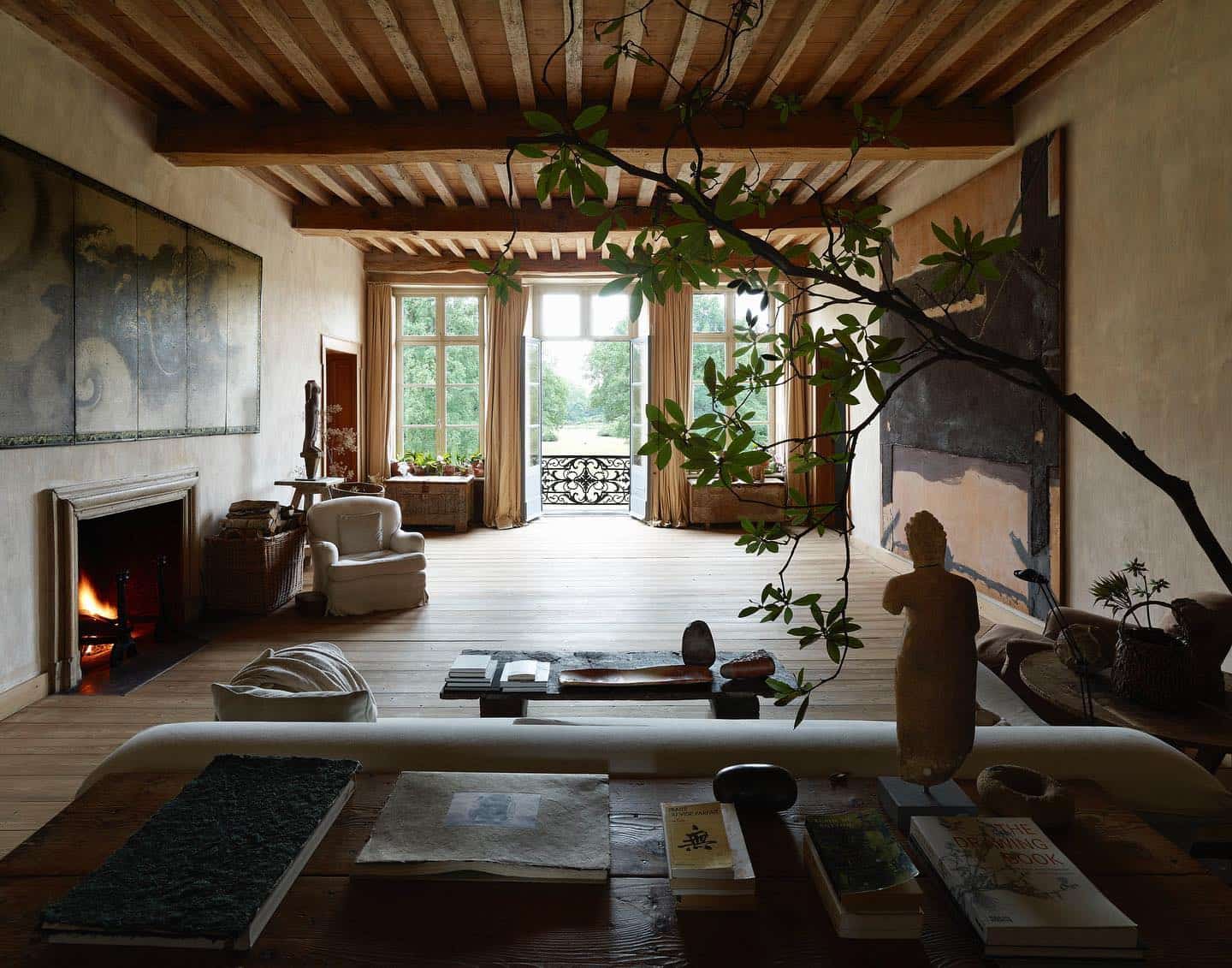Wabi-Sabi Meaning – Shifting and Fleeting
There is something uncharacteristic about connecting Japanese people with the idea of imperfection. After all, we are talking about a highly diligent, hard-working nation devoted to all aspects of their lives. The same society that praises art and beauty and always strives for better.
But is it really that contradictory? Or does true beauty lie precisely in the art of letting go?
Wabi-sabi stems from the Buddhist understanding of three basic life principles: impermanence (sanbōin), suffering (mujō), and emptiness or absence (kū).
If this sounds a bit downhearted, it’s because it is. Wabi-sabi prides itself on its acceptance of the transience and imperfection of life. According to its teaching, beauty can be found beneath the imperfect surface. Although gloomy at first, by the 15th century, the meaning of wabi-sabi was transformed into what we know today: finding joy in solitude, appreciating nature, lauding old-age wisdom, accepting that things come and go, and loving them honestly and deeply while they last.
Some of the most beloved traits of this outlook on life include modesty (austerity even), subtle grace, acceptance, earthiness, and peacefulness.
Wabi-Sabi Aesthetic – I Feel Pretty, Oh So Pretty
The philosophy of perfect imperfections permeates every aspect of the Japanese mindset, society, and art. Over the centuries, it has become a way of living and an integral part of every piece of art and design, creating its own aesthetic.
Wabi-sabi draws its inspiration from all things nature-related. It is inspired by the great outdoors while still being unassuming, simplistic, and somewhat minimalistic. One of the key features of wabi-sabi is asymmetry. Japanese art does not try to be perfect; artists, in fact, strive to add at least a hint of asymmetry to their design.
Poetic Ventures
For instance, Japanese poetry is almost inevitably asymmetric. Let’s take haiku as the most well-known example. A haiku is a short, three-lined poem with lines having five, seven, and five syllables. Rhyming in haikus is also frowned upon. Let’s take a look at Matsuo Basho’s most famous poem:
‘The Old Pond’
An old silent pond
A frog jumps into the pond—
Splash! Silence again.
Japanese poetry is somewhat reticent, which means every word has been chosen after careful consideration and carries multiple meanings and intentions. Basho’s poem juxtaposes two concepts – the silent pond and the eager frog making a splashing noise. The word silent is repeated with alteration (silence) to underline the mood. You can almost feel the serenity of the pond, with lotus flowers floating lazily, some water plants in the background, and the calm and quiet ambience.
The frog brings the contrast and breaks the silence by splashing around. The very sound is onomatopoeically summed up in the ‘splash!’ before silence returns, emphasising its short-lived nature. The whole poem resists any of our beloved rhyme, meter, or order except for the order and beauty in the atmosphere it creates.
Popular Culture
The very core of wabi-sabi philosophy can be found in all Japanese art forms, from ikebana (flower arrangement) to the popular anime and manga.
Check this out:

The protagonists’ hair may always be mad and colourful but never quite identical on both sides. Their expressions are exaggerated and keep changing, and each anime and manga ever made follows some change and addresses our fleeting existence. As all these heroes of our childhoods always like to say, ‘they want to be stronger’, continually improving, but never seeking pure perfection.
Wabi-Sabi Design – The Beauty in Everyday Items
Like art, wabi-sabi plays an indispensable role in fashion and design, becoming so present that most people don’t even notice it. Let’s look at some everyday items.

There is something absolutely stunning and so relaxing about this wabi-sabi interior design. The colours (gentle browns, creams, and greens) are meant to evoke nature, and the room is enriched by a few bonsai pots (another traditional art form) and a statue of Buddha (also asymmetrical). The room is beautifully but modestly appointed, and it invites you to sit and enjoy the view while taking a deep, meditative breath and being grateful for being there at that very moment.

Hey, we all like a good bite, and wabi-sabi doesn’t fail to provide kitchen solutions in its developing interior design streams. This room is rustic, to say the least, even though it’s equipped with modern appliances. Being tacky and overly boastful is not really welcome in this philosophy, so everything is toned down and made to seem homely and somehow from some other era.
Wabi-Sabi Fashion
Finding beauty in the everyday also includes the way we dress. This is especially true in Japan, which takes pride in diverse styles and aesthetics. But no matter how many distinctive styles there may be, they all have some wabi-sabi traits.
Those most devoted to the concept include Wabi-Sabi Eco-Fashion and Wabi-Sabi Styles. These companies make an effort to use natural materials in subdued tones that evoke nature. They are eco-friendly and geared towards customers’ needs, providing various clothing styles and choices. They also respond to the needs of street fashion, upholding the tradition of embracing the here and now, appreciating fleeting styles as much as traditional ones.


These comfortable, flowy designs just whisper spring in a forest, don’t they?
How Can You Use the Wabi-Sabi Philosophy to Improve Your Life?
Apart from your interest in the Japanese philosophy of imperfection (which, as you can see, is embedded in every aspect of Japanese life and mentality), you may be wondering how this helps you as a student. I mean, the StudySmarter Magazine is about all things student, after all. Here are some simple ways to incorporate this mollifying philosophy into your life:
- Give your living space a do-over. I am not saying that you should throw all your furniture out and spend tons of money on new ones, but maybe you could arrange your desk differently or add a bit of natural flair to it (some unassuming plant or a painting of the woods) to put you more in touch with nature.
- Start a new hobby. Ikebana and bonsai are two traditional Japanese practical art forms. If you love flowers, you can try ikebana. On the other hand, if your plant family needs company, you could get into bonsai gardening with some simple beginners’ kits.
- Learn to ground yourself and appreciate your life as it is. It is so easy to get lost in big dreams, plans for the future, and everyday worries (or existential dread), but sometimes you have to take a moment to appreciate just how far you’ve come. Call your family and tell them you love them. Talk to friends or take that art course – life is indeed fleeting, but it can be so beautiful!
- Practice uketamo, the art of acceptance. Uketamo is a Japanese word for complete and absolute acceptance of what is coming. Do not confuse it for giving up; uketamo refers to situations you cannot change in life. For example, you have to cancel your trip due to inclement weather – no point stressing over it. On a more serious note, uketamo accepts life and death as they come, but it does not make everything a matter of life and death. So what if you’ve had a bad day? Sleep on it and make the next one better.
- Apply wabi-sabi to your studies. By this, I don’t mean just saying, ‘oh well, it doesn’t need to be perfect’ and ditching anything that requires effort. But you could change your mindset. Not every course, homework assignment, or exam will be a breeze – that is the imperfect part of your studies, isn’t it? But even so, rising to these challenges makes you that much stronger, and one day, you will look back and be grateful you’ve conquered them (trust me, I am old, and I know!).
- Stop worrying so much about being perfect. Just like that. In the age of curated highlights on social media, it’s easy to doubt yourself and your life. Clothes, bodies, jobs, and vacations – everyone seems to have it all figured out, and it can make you insecure. Stop it. Someone’s highlight should not be your standard (careful, there be photoshopping there). Embrace yourself as you are and where you are in your life, and keep moving forward. Perfect imperfections make life’s best moments – enjoy them!
An Imperfect Road to a Perfect Outcome
Wabi-sabi is an uplifting philosophy that is deeply thoughtful about the nature of life and all the things we hold dear. Its teachings highlight the importance of appreciating every moment, every being, and every thing as their transient, imperfect nature makes them beautiful. It has become so ingrained in Japanese culture that it is a part of its every aspect – from art to how they deal with hardships.
To improve your mindset, try practising these fundamental teachings of wabi-sabi:
- Accept things as they are and as they come.
- Appreciate your life where it is now and work towards your goals.
- Strive for excellence, but don’t get caught up in perfectionism.
- Live your own perfect life with all its precious imperfections.







